I make a personal plea to anyone with the authority to do so: Please start importing Sternburg (and Sternburg Diesel) to the US.
http://en.wikipedia.org/wiki/Sternburg_Export
Thank you.
Wednesday, April 16, 2008
Thursday, April 10, 2008
I think Ichiro will go down in the baseball history books as this generation's most important player, or at least the one that has the most influence on Baseball's future. I'd venture to say that Ichiro is important to the game than A-Rod,Gone are the days of 'roided-up hulkamaniacs like Mark McGwire who rack up huge OPS points via home runs. Not only are the drugs just not that good anymore-- the parks are less hitter-friendly, and (accordingly) there are fewer terrible pitchers.
The statistics are changing-- Not just the numbers, but the statistics themselves. Win expectancy is gaining ground, and overall defense is on the verge of becoming a tangible statistic. That is to say that a player's contribution won't be measured by batting average or number of home runs, but by the actual influence they have on a game's outcome.
I doubt any players understand this better than Ichiro.
Outfield defense is a tough one to understand. Certainly you can look at a player's fielding percentage, or their assists, but it doesn't really paint the whole picture. And then there's showmanship-- In Seattle, we remember players like Ken Griffey making spectacular, wrist-breaking, diving catches and often equate that with defensive success. Ichiro never dives for a ball, or runs face-first into the outfield fence to rob a home run. Yeah, he has the speed, but what makes him an elite outfielder?
He understands his ability, and recognizes that his team can't afford to lose him due to injury. He's said several times that it's not worth risking it unless the season's on the line, which, statistically, is absolutely true.
Anyway, enough about defense. Let's change gears and look at his batting graph:
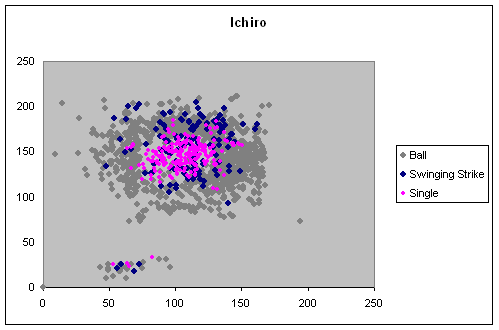
Since Ichiro isn't a power hitter, I elected to use singles here instead of home runs. A quick side note is that while it's not on a graph, all-- yeah, 100%-- of his doubles come from pitches up in the zone. Also keep in mind that Ichiro is a lefty.
What do we learn?
1) He gets beaten by pitches out of the strike zone. Especially ones that are up-and-in and low-and-in.
2) Pitchers try to exploit this by pitching middle-and-in, where he doesn't have any problems taking them for balls. I'm not sure why this is. Maybe someone's not doing their scouting homework properly.
3) Ichiro gets a ton a singles from pitches that are up-and-in, inside of the strike zone. These are where he leans back and serves it into shallow left field.
Nobody really plays like Ichiro, and he draws a lot of attention because of it. Pitchers have a strategy for him, and while it doesn't really seem to be working, they're sticking to it perhaps because they don't know what else to do.
The statistics are changing-- Not just the numbers, but the statistics themselves. Win expectancy is gaining ground, and overall defense is on the verge of becoming a tangible statistic. That is to say that a player's contribution won't be measured by batting average or number of home runs, but by the actual influence they have on a game's outcome.
I doubt any players understand this better than Ichiro.
Outfield defense is a tough one to understand. Certainly you can look at a player's fielding percentage, or their assists, but it doesn't really paint the whole picture. And then there's showmanship-- In Seattle, we remember players like Ken Griffey making spectacular, wrist-breaking, diving catches and often equate that with defensive success. Ichiro never dives for a ball, or runs face-first into the outfield fence to rob a home run. Yeah, he has the speed, but what makes him an elite outfielder?
He understands his ability, and recognizes that his team can't afford to lose him due to injury. He's said several times that it's not worth risking it unless the season's on the line, which, statistically, is absolutely true.
Anyway, enough about defense. Let's change gears and look at his batting graph:

Since Ichiro isn't a power hitter, I elected to use singles here instead of home runs. A quick side note is that while it's not on a graph, all-- yeah, 100%-- of his doubles come from pitches up in the zone. Also keep in mind that Ichiro is a lefty.
What do we learn?
1) He gets beaten by pitches out of the strike zone. Especially ones that are up-and-in and low-and-in.
2) Pitchers try to exploit this by pitching middle-and-in, where he doesn't have any problems taking them for balls. I'm not sure why this is. Maybe someone's not doing their scouting homework properly.
3) Ichiro gets a ton a singles from pitches that are up-and-in, inside of the strike zone. These are where he leans back and serves it into shallow left field.
Nobody really plays like Ichiro, and he draws a lot of attention because of it. Pitchers have a strategy for him, and while it doesn't really seem to be working, they're sticking to it perhaps because they don't know what else to do.
Monday, April 07, 2008
Baseball Stats: Part 2
Just for fun, I graphed out some 2007 data from players relevant to today's game. Let's start with Adrian Beltre and Daniel Cabrera:
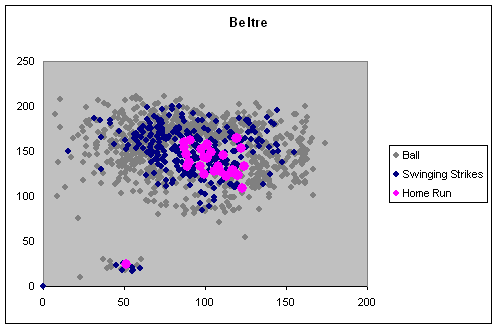
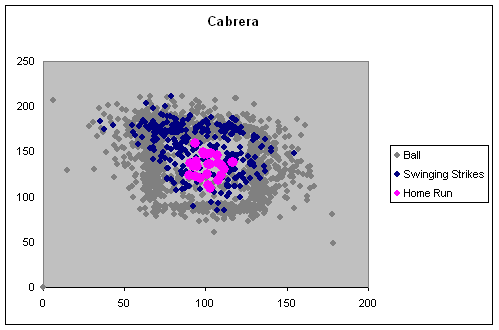
So. What do we learn here?
First of all, right-handed Beltre doesn't chase as many low and away sliders as you might expect. If he's going to get beat by a pitch, he's probably going to get beat by something up and in. According to the other graph, this is something that right-handed Cabrera likes to do. Expect strikeouts.
Cabrera also has excellent control and consistency around the edges of the strike zone. He stays low, and if he misses, he doesn't miss by much.
Here's another thing-- Cabrera doesn't give up home runs on the outsides of the plate. Compare him to the M's starter, Carlos Silva:
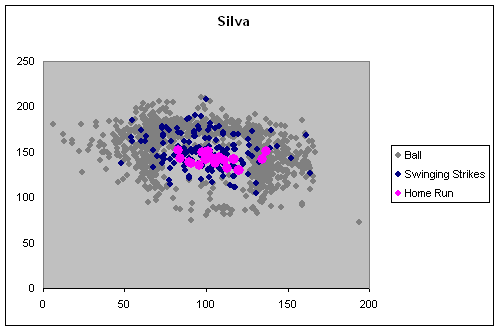
If Beltre's going to hit a home run off of Cabrera, then, it's probably going to have
be within that small central margin. But he's got a much better shot at it than Richie Sexson, who swings a bit more freely:
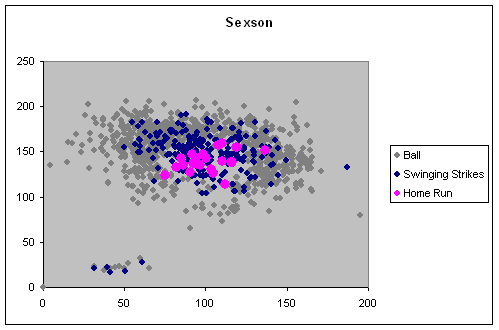
I'm not using any pitch f/x data here, just location. There's a lot more to be said when taking break and deception into account. And obviously, pitchers (and catchers) are aware of these types of batting tendencies, and the smart ones will find a way to tilt the odds in their favor (note to self: It would be interesting to analyze a pitcher's intelligence in facing different batters. Maybe this will be a future update).
Baseball Stats: Part 1
It might not be common knowledge that nearly every Big League baseball park in America has a system that can track a pitch's movement, break, release point, starting/finishing velocities, and a host of other details. And for some reason, Major League Baseball compiles and archives all of this data for public consumption on their website.
And it's all for free! I know, something for nothing. It doesn't seem quite right, considering that this is the American pasttime and all.
Anyway, there's a ton of data to look at. A ridiculous amount. People analyze this stuff for a living and I don't think anyone's even scratched the surface of what it can reveal about the nature of the game.
Because the data is stored very inconveniently on the MLB servers (in a weird esoteric directory structure), the average fan effectively doesn't have access. And based on the way most MLB games are managed, I sort of doubt that even the experts have adequate access. You see, the files are really only accessable to a small percentage of the population:

Baseball is different than many spectator sports because there are relatively few intangibles. Every possible action is decided by some variant of bat-hits-ball, and now that we have access to the flight path of every pitch and how each individual batter reacted to it, there's room for a lot of insight that hasn't been made before.
And it's all for free! I know, something for nothing. It doesn't seem quite right, considering that this is the American pasttime and all.
Anyway, there's a ton of data to look at. A ridiculous amount. People analyze this stuff for a living and I don't think anyone's even scratched the surface of what it can reveal about the nature of the game.
Because the data is stored very inconveniently on the MLB servers (in a weird esoteric directory structure), the average fan effectively doesn't have access. And based on the way most MLB games are managed, I sort of doubt that even the experts have adequate access. You see, the files are really only accessable to a small percentage of the population:

Baseball is different than many spectator sports because there are relatively few intangibles. Every possible action is decided by some variant of bat-hits-ball, and now that we have access to the flight path of every pitch and how each individual batter reacted to it, there's room for a lot of insight that hasn't been made before.
Wednesday, April 02, 2008
The Church of ScientoIogy and Me
On April 12th, a group called Anonymous will be staging another worldwide protest against the shady practices of the Church of ScientoIogy.
People who know me well already know about my run(s)-in with the Church and its affiliates. Quickly stated, I support ScientoIogy as a faith-- Although I'm not religious, freedom of worship is an obviously vital part of free society, and the right is defensible in any discussion about freedom of speech.
The Church itself, however, has come to abuse my ideal of religious tolerance in a very contradictory way: One that explicity promises superpowers for right price, forces "disconnection" with friends and family, twists copyright law to destroy splinter groups and silence dissenters. The problem isn't the tenets of the faith, but the Church's power and savvy as a business to operate outside the law. As a Church, they're not only tax-exempt, but immune to the sort of criticism that would normally provoke public outcry.
Fortunately, the ruse looks like it's coming to an end, as The Church of ScientoIogy is having more and more trouble flying under the radar. This is largely a product of collaborative knowledge on the Internet and is, in my estimation, the first of many organizations facing the full brunt of Internet activism. It's really an amazing effort-- During the last round of protests, over 150 showed up at the Church's headquarters in Florida. There were thousands more protesters worldwide.
But the most interesting parts to me are the extremes it represents. On one hand, there is Anonymous: A group with no central leadership, no experience, no financial or political power, armed only with knowledge and a sense of making things right. On the other hand: The Church of ScientoIogy.
This is a perfect microcosm of what could happen on a much larger scale. Even if you're not interested in the protests against the Church, they are setting a prescident for other (bigger) social issues.
People who know me well already know about my run(s)-in with the Church and its affiliates. Quickly stated, I support ScientoIogy as a faith-- Although I'm not religious, freedom of worship is an obviously vital part of free society, and the right is defensible in any discussion about freedom of speech.
The Church itself, however, has come to abuse my ideal of religious tolerance in a very contradictory way: One that explicity promises superpowers for right price, forces "disconnection" with friends and family, twists copyright law to destroy splinter groups and silence dissenters. The problem isn't the tenets of the faith, but the Church's power and savvy as a business to operate outside the law. As a Church, they're not only tax-exempt, but immune to the sort of criticism that would normally provoke public outcry.
Fortunately, the ruse looks like it's coming to an end, as The Church of ScientoIogy is having more and more trouble flying under the radar. This is largely a product of collaborative knowledge on the Internet and is, in my estimation, the first of many organizations facing the full brunt of Internet activism. It's really an amazing effort-- During the last round of protests, over 150 showed up at the Church's headquarters in Florida. There were thousands more protesters worldwide.
But the most interesting parts to me are the extremes it represents. On one hand, there is Anonymous: A group with no central leadership, no experience, no financial or political power, armed only with knowledge and a sense of making things right. On the other hand: The Church of ScientoIogy.
This is a perfect microcosm of what could happen on a much larger scale. Even if you're not interested in the protests against the Church, they are setting a prescident for other (bigger) social issues.
Tuesday, April 01, 2008
I bought something weird
Call me crazy, but I'm kind of obsessed with computer keyboards. I think it's for good reason, though-- I probably type more words on any given day than I speak. Doesn't that make my keyboard worth obsessing over?
I use an IBM Model M keyboard that I bought off eBay. Among enthusiasts, the Model M is king. They have a fantastic "clicky" feeling to them, they're laid out perfectly, and they're nearly indestructable. Mine was made in 1984, and it's as good as new. Sadly, they've been more or less discontinued since 1992, in favor of cheaper, flimsier keyboards that are made to be replaced every few years.
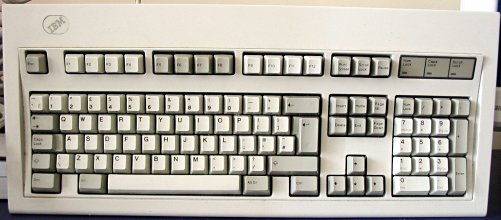
Until yesterday. I thought it was impossible to improve on the Model M. But check out what I bought for six dollars at Goodwill:

First of all, the styling is, like, awesome. It's only missing some flames. Also, It's USB, comes with an ergonomic built-in joystick, and inexplicably has some sort of wrist strap on the back. For six dollars, It's breathtaking.
I think I'm going to attach a guitar strap to it and sling it over my back like some sort of digital mariachi renegade. Think Antonio Banderas but worse shape and way, way paler.
I use an IBM Model M keyboard that I bought off eBay. Among enthusiasts, the Model M is king. They have a fantastic "clicky" feeling to them, they're laid out perfectly, and they're nearly indestructable. Mine was made in 1984, and it's as good as new. Sadly, they've been more or less discontinued since 1992, in favor of cheaper, flimsier keyboards that are made to be replaced every few years.

Until yesterday. I thought it was impossible to improve on the Model M. But check out what I bought for six dollars at Goodwill:

First of all, the styling is, like, awesome. It's only missing some flames. Also, It's USB, comes with an ergonomic built-in joystick, and inexplicably has some sort of wrist strap on the back. For six dollars, It's breathtaking.
I think I'm going to attach a guitar strap to it and sling it over my back like some sort of digital mariachi renegade. Think Antonio Banderas but worse shape and way, way paler.
Subscribe to:
Comments (Atom)